- Operation Black Thunder
-
Operation Black Thunder is the name given to two operations that took place in India in the late 1980s to flush out remaining Sikh extremists from the Golden Temple using 'Black Cat' commandos of the National Security Guards[1] Like Operation Blue Star, these attacks were on Khalistani militants who were using the Golden Temple in Amritsar, Punjab as a base.
Operation Black Thunder I
The first Operation Black Thunder took place on 30 April 1986. About 300 National Security Guards commandos stormed the Golden Temple along with 700 Border Security Force troops and captured about 300 separatists.[2] Only 1 person was killed and 2 were injured. The operation, which lasted eight hours, was approved by then Chief minister of Punjab Surjit Singh Barnala of Shiromani Akali Dal.[2]
Operation Black Thunder II
Operation Black Thunder II (sometimes just referred to as Operation Black Thunder) began on 9 May 1988[3] in Amritsar and ended with the surrender of the militants on 18 May. The operation was commanded by Kanwar Pal Singh Gill who was the DGP of Punjab Police. Snipers were used in this operation.[4] Compared to Operation Blue Star, little damage was inflicted on the Golden Temple.[5] In what was reported as a successful operation, around 200 millitants surrendered, 41 were killed. Gill stated that he did not want to repeat the mistakes made by the Indian army during Operation Blue Star.[6] This operation was described as a severe setback to the Khalistan movement. In contrast to prior operations, minimum force was used under full public scrutiny.[7] It is remembered for the free access the news media was provided unlike during Operation Blue Star.[8] The day after the militants surrendered nine reporters were allowed into the Temple complex.[9] Kirtan was resumed at the Golden Temple on 23 May 1988 after a two week break during this operation.[10]
While Operation Blue Star was widely considered poorly executed due to the casualties suffered by the assault force and the damage done to both the temple and attitude of Sikhs toward the government (resulting in the assassination of Indira Gandhi by her bodyguards and anti-Sikh riots), Operation Black Thunder was far more successful with the blockade tactics paying rich dividends, with only two wounded Black Cats, and has been credited with breaking the back of the Sikh separatist movement. Soon after this operation the Indian Government banned the use of religious shrines for political and military purposes and increased penalties for the possession and use of illegal weapons, as part of its strategy to fight extremism in the Punjab.[11]
In 2002 Sarabjit Singh who was the Deputy Commissioner of Amritsar at the time published a book "Operation Black Thunder: An Eyewitness Account of Terrorism in Punjab". The account was criticized by Kanwar Pal Singh Gill who claimed that the operation was initially called "Operation Gill" before being renamed "Operation Black Thunder".[12]
References
- ^ National Security Guards
- ^ a b India Deliverance, TIME, 1986-05-12
- ^ Gandhi Under Pressure to Oust Sikhs From TempleThe New York Times, 1988-05-11
- ^ Troops in Punjab Enter Sikh Temple ComplexThe New York Times, 1988-05-14
- ^ INDIAN COMMANDOS CLOSE IN ON SIKHS, The New York Times, 1988-05-18
- ^ Sikhs Surrender to Troops at Temple, The New York Times, 1988-05-19
- ^ Terrorism in context By Martha Crenshaw
- ^ Black Thunder’s silver lining, The Hindustan Times, 2008-05-13
- ^ At Golden Temple of Sikhs, the Debris of BattleThe New York Times, 1988-05-20
- ^ At Sikh Temple, an Uncertain Song Returns, The New York Times, 1988-05-23
- ^ India Bans the Political and Military Use of ShrinesThe New York Times, 1988-05-29
- ^ Now, Gill slams author of Operation Black Thunder, Rediff.com, 2002-07-29
Categories:- Independent India
- 1986 in India
- 1988 in India
- History of Sikhism
- Terrorism in India
- Amritsar
- Punjab insurgency
- History of Punjab (India)
Wikimedia Foundation. 2010.

